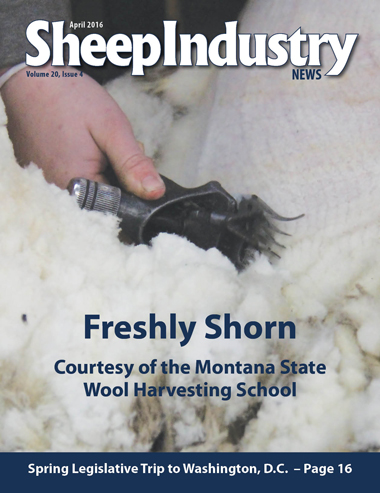
- April 2016
- President’s Notes
- ASI Legislative Trip
- Sage Grouse Discussion
- Changes for Price Reporting
- Shearing 101 in Montana
- Science of Bighorn Report Questioned
- USSES Reports Available
- American Lamb Board Vacancies for 2017
- Market Report
- NLFA Leadership School in Ohio
- Sheep Heritage Foundation Scholarship
- Around the States
- The Last Word
Sage Grouse Discussion with BLM, USFS
JUDY MALONE
ASI Director of Industry Information
As part of their visit to Washington, D.C., on March 14-17, sheep industry leaders met with the Bureau of Land Management and the U.S. Forest Service. A common topic at both meetings was the impact the sage grouse would have on grazing allotments.
At the Bureau of Land Management, Rangeland Division, Division Chief Joe Tague and Natural Resources Specialist Richard Mayberry talked openly with sheep producers about the agency’s implementation of the sage grouse rule as it applies to grazing allotments. A more concerted effort will be followed to monitor allotments to see if they meet the habitat objectives for the sage grouse. Through this process, prioritization of grazing allotment renewals will no longer be driven by renewal dates but instead by the habitat objectives of the specific allotment and its relative proximity to sage grouse focal areas. Allotment priorities on grazing allotments, according to the BLM, include sage brush, priority habitat and then general habitat, in that order.
When questioned about how the agency plans to assure ranchers that the rule will be applied consistently at the state and local levels, Mayberry and Tague cited the development of guidelines, assuring a clear understanding of the intent of the rule, training sessions, more feedback loops and providing the latitude for local implementation as keys to success.
The impact of wild horses on the habitat and predators on the survival of the sage grouse were also discussed. Mayberry assures attendees that BLM is “not looking to analyze the permittee on things that are not the permittees.” He also assured producers that BLM recognizes the threat wild horses pose to rangelands and the need to get numbers down to AML, which means removing approximately 50,000 excess horses from the landscape. Like permit renewals, gathers will be focused initially on sage grouse focal areas, rather than in the areas with the largest overpopulations – a prioritization that is concerning to permittees struggling with rapidly expanding herds.
A disappointing note from the meeting, BLM hardly mentioned to the ranchers their policy guidance development on bighorn sheep when it was released to the public the very next day.
At the forest service, producers met with USFS Director of Rangelands Management Allan Rowley and Assistant Director Ralph Giffen. Rowley began the meeting by drawing a distinction between the BLM and FS processes for reviewing and approving permits. He wanted producers to understand that the BLM conducts their assessment while issuing or renewing a permit whereas the Forest Service makes that determination when deciding to allow grazing at all.
Regarding the implementation of the sage grouse plans, Rowley stated that evaluation of habitat would begin during this summer and stretch into 2017. He told producers not to expect any changes in their permits until probably 2018 at the earliest. Additionally, he said the assessments would fall into three categories:
1. Sage grouse is present and the habitat is well managed – therefore no change is needed
2. Sage grouse is present and the season of use must be shifted by a few weeks to optimize recovery
3. Major conflict – additional study needed.
Regardless of the category, Rowley explained that amending permits would be an administrative action. He also commented that in assessing sage grouse landscapes, the habitat – not presence of birds – would be the controlling factor.
Rowley also mentioned that the forest service would hold a meeting in Idaho next month to begin looking at habitat and discuss the ecological site descriptions needed, which will be prepared in coordination with NRCS and BLM.

